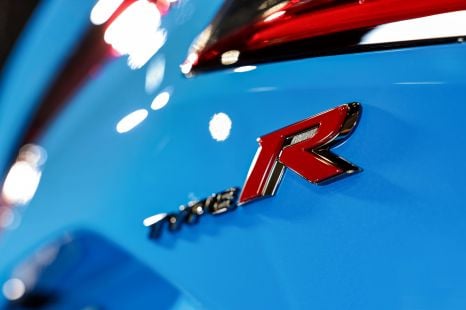

Damion Smy
Honda Prelude Type R ruled out... for now
6 Hours Ago
Airbags are an important, life-saving technology. But what type of airbags are there and how do they work?

Contributor


Contributor
Airbags are a fundamental safety technology in vehicles sold today. As their name suggests, they are inflatable bags of gas that act as a cushion to reduce the forces experienced by vehicle occupants during a collision.
Almost every new car and commercial vehicle sold in Australia has driver and front passenger airbags. Many vehicles also offer other airbags such as curtain airbags.
Airbags are also known by the term ‘SRS’ (Supplementary Restraint System) as they supplement other safety equipment in a car, such as seat belts, when protecting vehicle occupants during a crash.
An airbag is a nylon bag. When deflated these nylon bags are packed behind various parts of the interior, such as the steering wheel boss and dashboard for front airbags.

Whether an airbag operates is based on the forces experienced during a collision. During a collision, there is a rapid change in speed of the vehicle, and consequently a high level of deceleration and g-forces experienced by vehicle occupants.
Sensors such as gyroscopes and accelerometers placed around the car are able to detect the magnitude and direction of these forces.
An Airbag Control Module (ACM) acts as a small computer that constantly monitors data from these sensors. If a sudden change is detected, the ACM quickly works out the direction and severity of the impact, and makes a decision as to which airbags to deploy to best protect the vehicle occupants.
In addition to the sensors and ACM, an airbag system also contains an inflator that blows up the airbag when a crash occurs. The inflator system actually shares some similarities to solid propellant rocket boosters.
An electrical charge is sent to a heating element (known as the igniter) which burns a solid propellant, usually sodium azide or nitroguanidine.
The propellant reacts explosively with ammonium nitrate to form nitrogen gas, which then inflates the airbag. This entire reaction, inflation and deployment process is extremely rapid, taking only 50 milliseconds. For comparison, humans take around 200 milliseconds to blink their eyes.
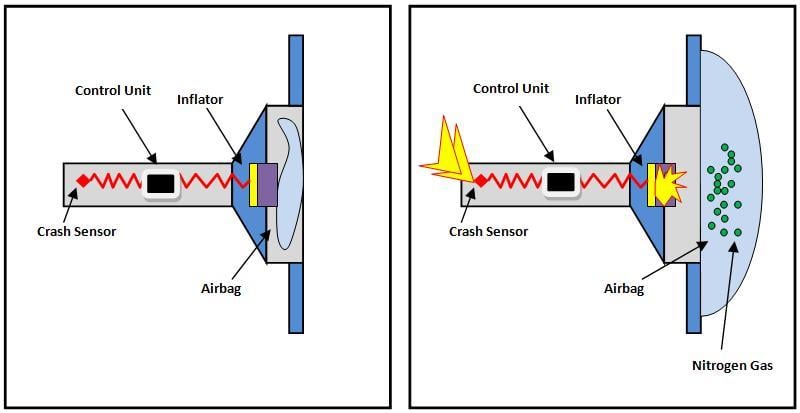
It’s important to note that with airbags deflation is just as important as inflation. At the point of contact between the airbag and the vehicle occupants, the airbag is already deflating. Otherwise their heads or limbs would bounce off, mitigating the airbag’s ability to absorb energy.
Almost every car and commercial vehicle sold today comes standard with dual frontal airbags, which aim to protect the driver and front passenger’s head and chest in the event of a head-on collision.
Curtainairbags deploy from the roof lining just above the side doors, and cover the side windows and doors when inflated. They aim to protect occupants from side impacts or T-bone crashes. Seat-mounted side airbags also intend to reduce potential injuries during a side impact, however they deploy from the outer seat cushion and are geared towards protecting the torso.
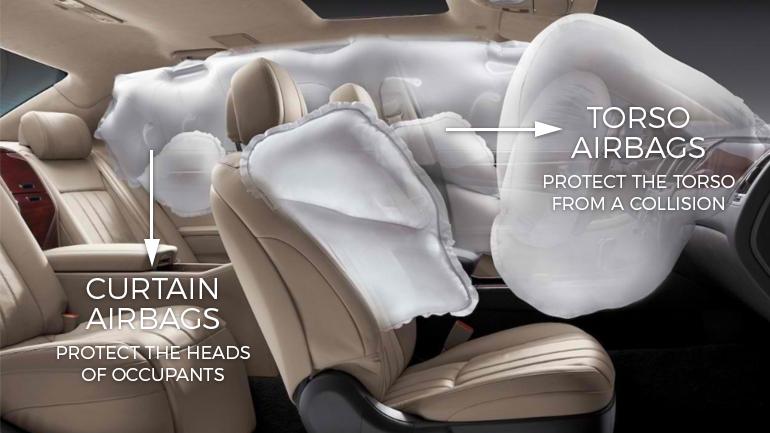
Most cars today come with side curtain airbags in addition to dual frontal airbags, with seat-mounted airbags being optional or the domain of more expensive vehicles.
An important point to check when purchasing an SUV or vehicle with seven seats is to ensure that the curtain airbags offer coverage for all three rows of occupants, including the rear-most seats. Also, if a vehicle is equipped with seat mounted airbags it may not be compatible with seat covers.
Knee airbags are mounted in the lower section of the front centre console or dashboard, and aim to protect the driver’s (and front passenger if equipped) knees and shins.

Inflatable seat-belts are another technology offered on certain Ford and Mercedes-Benz vehicles. This innovation incorporates an airbag into the rear seatbelts, which works to tighten and spread the force of an impact over a greater area than a typical seatbelt in the event of crash, reducing the risk of chest and head injuries.
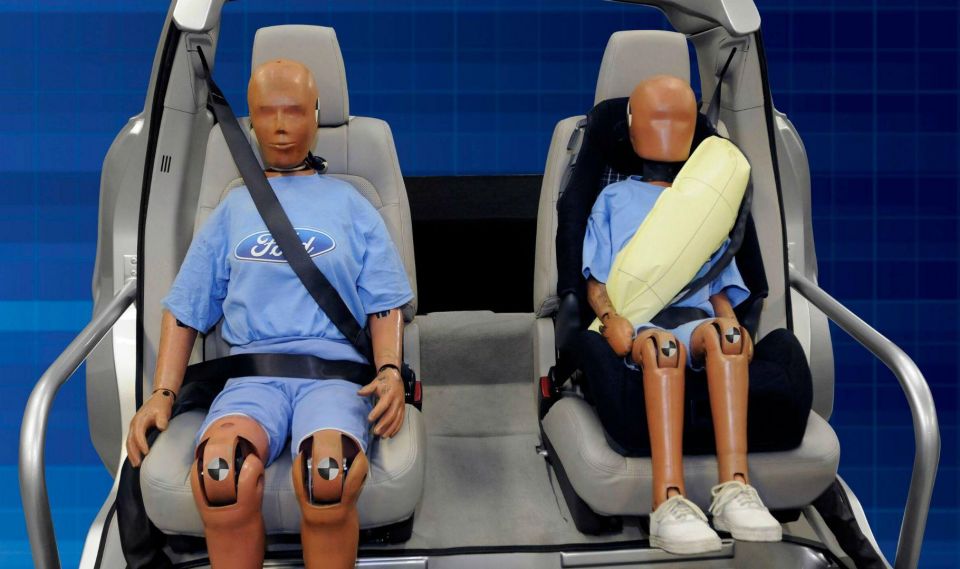
More recently, vehicles such as the new Toyota Yaris and Isuzu D-Max/Mazda BT-50 twins include a front centre airbag. This deploys from the inside cushion of the driver’s seat, and aims to reduce the potential of front passengers hitting and hurting each other during a side or frontal collision.
Mercedes-Benz is widely regarded as a pioneer of advanced safety systems, and one of its recent innovations in the airbag space is the rear frontal airbag.
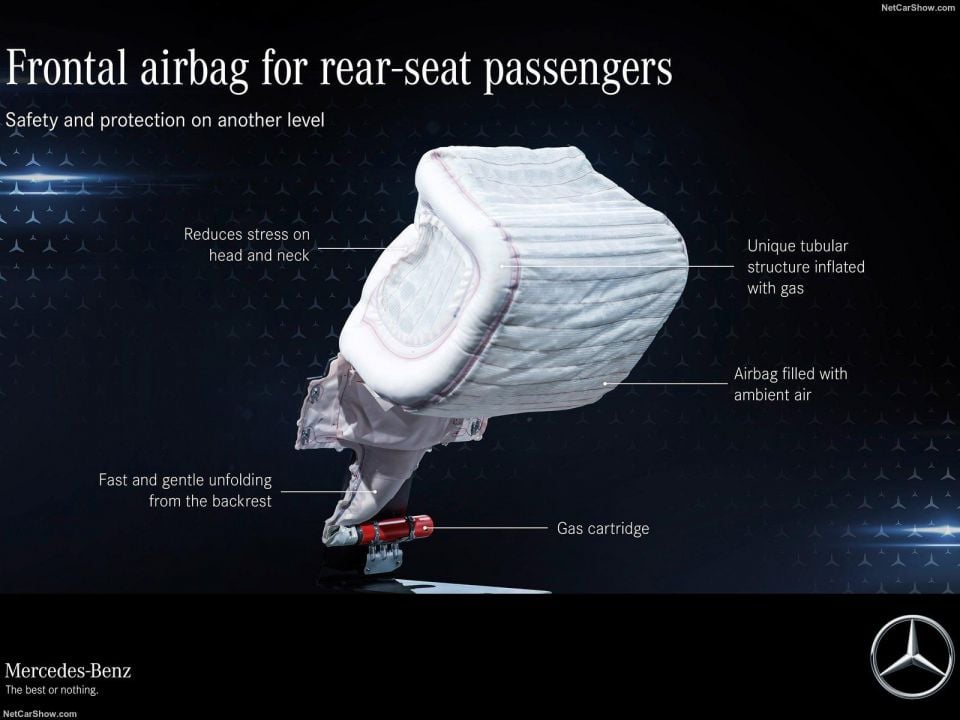

Introduced in the 2021 S-Class this airbag uses a tubular structure, and deploys from the backrest to protect the head and chest of rear occupants.
In addition to nitrogen gas, one of the products of the airbag inflation process is sound from the explosive reaction between the propellants. The magnitude of this noise can cause temporary or permanent hearing loss.
Pre-Safe Sound is another innovation from Mercedes aiming to prime the ear to better tolerate the noise emitted during airbag inflation and crashes. If the car anticipates that a severe collision is imminent, Pre-Safe sound will play ambient ‘pink noise’ at 80 decibels for a short time through the car’s audio system.
This triggers a reflex that partially blocks further loud noises from entering the inner ear, protecting occupants’ hearing.
Another recent development are dual or multi-stage airbags. These have multiple inflator systems connected to a single airbag. Each inflator has a different power rating, to the extent that the airbag inflates to a different volume depending on the severity of the crash.
Note that a vehicle having more airbags than a competitor does not necessarily make it a safer car. Other features, such as the design of the crash structures, can be just as important in mitigating the risk of injury.
The best bet is to always check a car’s ANCAP safety rating for an overall guide to how safe a vehicle is.
Takata is the largest recall in automotive history, involving 100 million vehicles globally and 3 million in Australia. But what went wrong?
The primary flaw in airbags made by Takata is with the design of the inflators that used ammonium nitrate as part of the propellant mix.

In certain conditions moisture can enter into the propellant, destabilising it. When the airbag is activated during a crash, the explosive reaction between the propellants may cause the metal inflator housing to rupture.
Fragments of this housing (effectively shrapnel) could strike the vehicle occupants, maiming or killing them.
You can check whether your car is affected by the Takata airbag recall at the “Is My Airbag Safe” website.
If affected, it is critically important to get your vehicle fixed at the earliest opportunity.


Damion Smy
6 Hours Ago


Damion Smy
9 Hours Ago


Damion Smy
10 Hours Ago


Matt Robinson
13 Hours Ago


Damion Smy
13 Hours Ago


Damion Smy
1 Day Ago